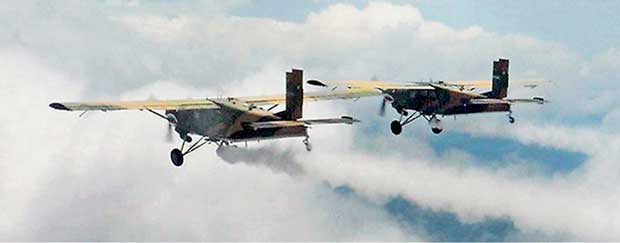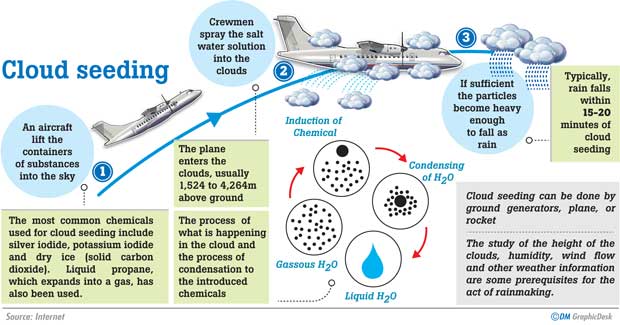Reply To:
Name - Reply Comment
Last Updated : 2024-04-26 07:28:00
It is no mystery that prolonged dry spells have caused difficulties for power generation in Sri Lanka. While sporadic rains in several parts of the island have brought much needed relief, officials have long warned that the conditions of drought would be unrelenting for many areas.
 According to Power and Energy Ministry spokesman Sulakshana Jayawardenathe generation of hydro power has been a challenge as water levels at reservoirs are currently around an estimated 59%. 1,350MW of Sri Lanka’s total power capacity, is generated employing large scare hydro-power plants while another 350 MW is generated by small-scale hydro-power plants. The Ministry of Power and Renewable Energy together with the Ceylon Electricity Board is attempting to remedy this state of affairs by ‘making’ rain.
According to Power and Energy Ministry spokesman Sulakshana Jayawardenathe generation of hydro power has been a challenge as water levels at reservoirs are currently around an estimated 59%. 1,350MW of Sri Lanka’s total power capacity, is generated employing large scare hydro-power plants while another 350 MW is generated by small-scale hydro-power plants. The Ministry of Power and Renewable Energy together with the Ceylon Electricity Board is attempting to remedy this state of affairs by ‘making’ rain.
“Sri Lanka usually expects precipitation during the two monsoon seasons, namely the North-East and South-West monsoons. Over the past two years however we didn’t receive sufficient rain which caused difficulty in producing energy. With this experience, the Ministry decided to explore the possibility of rainmaking,” he said.

Humans have been attempting to control weather since ancient times. ‘Rainmaking’ isn’t just an indigenous ritual to invoke rains practised by many ancient cultures. Rainmaking is also a scientific weather modification process or a technique of intentionally manipulating the atmosphere, backed by years of research. It involves a process of impregnating clouds to instigate the precipitation process.
We requested the Ministry of Foreign Affairs to assist us in bringing down expertise from other countries where rainmaking is used for diverse purposes, including agriculture. Out of many countries where cloud seeding is practised, Thailand was selected on the premise that they assisted us to create rain in Sri Lanka when the island was struck with a severe drought in 1981
“Our attempt was to induce rains during the monsoons and not to create ‘artificial’ rain during the dry seasons. During the monsoons there are ideal cloud conditions, but most often we experience no rain. The challenge is to create enough rainfall in the catchment areas where the major reservoirs are located, namely the Samanala Wewa, Castereigh, Kotmale, Randenigala and Victoria reservoirs,” Jayawardena explained
“If we receive rainfall as expected we can use it during the dry season when water is scarce. There have been many misconceptions about this project as some have mistakenly reported that we will induce rain during the dry seasons. This is not our objective,” the spokesperson stressed.
Sri Lanka experienced heavy rains in areas such as Kalutara, Galle and Matara, even causing floods and widespread destruction. However this precipitation is of no avail as it is not received in catchment areas in the central highlands.
They visited the reservoirs Maussakele, Castlereagh, Victoria and Kotmale to gather data for the feasibility study. With the preliminary findings presented towards the end of the visit, the experts had concluded that rainmaking was a possibility in Sri Lanka
“We requested the Ministry of Foreign Affairs to assist us in bringing down expertise from other countries where rainmaking is used for diverse purposes, including agriculture. Out of many countries where cloud seeding is practised, Thailand was selected on the premise that they assisted us to create rain in Sri Lanka when the island was struck with a severe drought in 1981,” Jayawardena said. At that time the project was carried out by several stakeholders including the Sri Lanka Air Force, Ceylon Electricity Board, Meteorological Department and the Mahaweli Authority.
A delegation of five engineers including the Director General of Department of Royal Rainmaking and Agricultural Aviation (DRRAA) arrived in the island on Monday. (February 22). Following a knowledge sharing session, the experts embarked on a fact finding mission in Central Highlands where a drastic drop in water levels has been recorded. They visited the reservoirs Maussakele, Castlereagh, Victoria and Kotmale to gather data for the feasibility study.

With the preliminary findings presented towards the end of the visit, the experts had concluded that rainmaking was a possibility in Sri Lanka. “The experts agreed to share their knowledge with us. We are now in the process of obtaining Cabinet approval to sign a Memorandum of Understanding (MoU) between the two countries to proceed with this venture,” Jayawardena said.
The project is expected to be expensive. However Jayewardene noted that expenditure estimates have not been drafted as the two countries are still examining the feasibility. “The Thai team requested that weather information be provided from the Sri Lankan authorities. They noted that existing aircraft in possession of the Sri Lanka Air Force can be used with some digital modifications for this project,” he said.
Over the course of the next month, a Sri Lankan team will visit Thailand to observe the practical methodology of cloud seeding. “They agreed to host Sri Lankan professionals, so that we can receive the practical exposure to their technology before we embark on the project,” Jayawardena said.
The study of the height of the clouds, humidity, wind flow and other weather information are some prerequisites for the act of rainmaking. Officials at the Department of Meteorology will collaborate with this project by providing technical assistance. An officer of the Met Department said they would assist this project in providing details such as atmospheric data. Speaking on the concerns raised over the project the Met Department said that the project is likely to result in positive outcomes rather than negative. However the Met Department official said as weather is inherently an uncertain phenomenon, caution should be exercised as theory may differ from reality.
“The Thai experts are in possession of the scientific know-how and the technology. We do not know of the result until it is practically applied,” the officer cautioned.
As of February 21, 91, 858 families across five districts: Puttlam, Kurunegala, Anuradhapura, Polonnaruwa and Mannar have been affected by this drought. Even though change of weather patterns possesses a greater challenge to countries highly dependent on agriculture such as Sri Lanka, it is not alone in grappling with the issue.
According to the World Meteorological Organization, more than 50 countries across the world have adopted operational programmes to modify the weather.
Dubbed cloud seeding programmes are often carried out by 34 private weather modification companies in countries including the United States, China, Indonesia, Russia and several Middle Eastern and European countries.
Thailand’s rainmaking techniques however share an interesting historical account with the country’s beloved monarch who ruled the country from 1946 until his demise in 2016. Late King Bhumibol Adulyadej was adored by his countrymen for he was the definition of royal benevolence. One area he was particularly interested in constantly improving was agriculture.
Disaster statistics from the 1900s to 2000s indicated that the droughts affected more than 10 million people in Thailand. The country was affected by droughts frequently and repeatedly, raising the need to address the issue immediately. In 1955, during a visit to the remote north-eastern provinces, the King had observed how cloudy conditions were ideal for rain, yet failed to produce any precipitation.
In 1969 the first trial of the artificial rain carried out under the supervision of the King himself was hailed a success. Rainfall was recorded in targeted areas in Pak Chong District, Nakhon Ratchasima and subsequently known as the Royal Rainmaking Project. In 1999, Bhumibol discovered an innovative technique to gain more cloud density and increase the amount and extent of rainfall. He named the new cloud-seeding technique ‘Super Sandwich’.
In 1969 the first trial of the artificial rain carried out under the supervision of the King himself was hailed a success. Rainfall was recorded in targeted areas in Pak Chong District, Nakhon Ratchasima and subsequently known as the Royal Rainmaking Project
The Thai King was the world’s first monarch to apply for and be granted a patent for this own invention in 2003. The success has led to the establishment of the Thai Department of Royal Rainmaking and Agricultural Aviation, involved with design and implementation of a series of experiments which resulted in the establishment of five Royal Rainmaking operations centre in every region of the country.
The Director of the National Centre for Meteorology and Seismology in the United Arab Emirates (UAE) Dr. Abdullah Al Mandoos more than once cautioned that “any country with a plan to implement cloud seeding projects requires to investigate the physical and chemical properties of the frequent and available clouds in their territory.” Despite decades of research and success stories, scepticism divides scientists and Governments on cloud seeding -especially due to the challenge of verifying the efficacy of the technique, establishing cause and effect and the overall variability of weather systems.

Add comment
Comments will be edited (grammar, spelling and slang) and authorized at the discretion of Daily Mirror online. The website also has the right not to publish selected comments.
Reply To:
Name - Reply Comment
US authorities are currently reviewing the manifest of every cargo aboard MV
On March 26, a couple arriving from Thailand was arrested with 88 live animal
According to villagers from Naula-Moragolla out of 105 families 80 can afford
Is the situation in Sri Lanka so grim that locals harbour hope that they coul